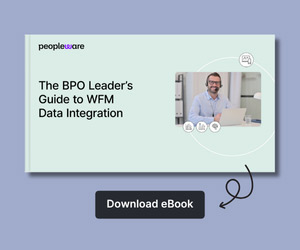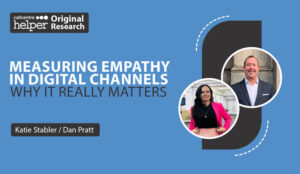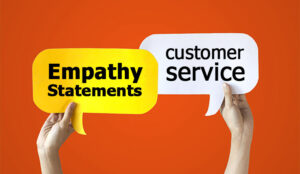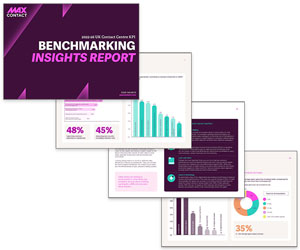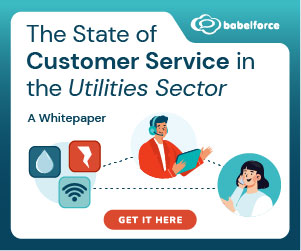The QA landscape for digital channels is shifting. In most operations, compliance still leads what’s tracked, but with empathy close behind, it’s a clear signal that empathy is no longer a “nice to have” but central to trust, de-escalation, and resolution quality.
This makes it ever-more critical to be measuring empathy well across all digital channels, which is why we’ve put the spotlight on the latest research from our readers and spoken to CX experts Dan Pratt and Katie Stabler to help you succeed.
Modern Customers Expect Fast, Accurate and Genuinely Considerate Service
Our latest research revealed that customer contact leaders are increasingly casting their eyes on measuring advisor empathy in their digital channels. Why? Modern customers expect service that is fast, accurate and genuinely considerate, not just polite!
Empathy metrics help teams calibrate coaching, balance meaningful speed with clarity, and demonstrate improvements beyond tone and grammar, which are now baseline expectations.
To delve into the details, we spoke with CX expert Dan Pratt to talk more about why measuring empathy is vital, and what the best leaders are doing right now to measure it more effectively.
This Is More Important Than Ever as Contact Centres Continue to Diversify Their Channel Offerings
This is ever more important as contact centres continue to explore channel diversification and extend their offering across multiple social media channels too – including Facebook, Instagram, LinkedIn and WhatsApp, as Katie Stabler, CULTIVATE Customer Experience by Design and author of CX-Ism: Re-Defining Business Success explains:
“When asked “What Additional Channels Do You Use to Interact With Customers?”, survey respondents highlighted an evolving but seemingly cautious approach to channel diversification in customer engagement.
Interestingly, Facebook continues to dominate (34%) for those utilizing ‘alternative’ channels, likely because of its established user base, ease of use, and built-in business tools like Messenger, reviews, and appointment bookings.
Instagram (22%) and LinkedIn (20%) feature strongly, possibly reflecting a shift in how brands build customer relationships. Instagram offers a more visual, lifestyle-driven connection, while LinkedIn supports B2B engagement and thought leadership.
Meanwhile, WhatsApp (19.4%) and X (17%) suggest that conversational commerce and real-time communication exist only in select industries or customer segments.”
So, What Does Empathy Look Like Online?
With a growing spotlight on digital channels, it’s important to tailor your approach depending on which channels your contact centre use most – for example:
Acknowledge the customer’s context in the opener, state what you’ve understood, then give plain-English next steps and ownership, e.g. “I’ll do X and get back to you by Y.” This balances care with clarity.
Live Chat / Messaging
Respond quickly with a human acknowledgement, reflect back the problem in one line, and signpost timeframes like: “This normally takes up to two hours. Shall I keep the chat open or message you when it’s done?” The best advisors combine empathy with meaningful speed.
Here’s a list of Empathy Statements for Customer Service With Examples to help.
Social Channels
Defuse publicly, resolve privately, then close the loop on the original thread so others see it’s been handled. In compliance-sensitive verticals this keeps trust high.
Here are the 5 Pitfalls of Social Media Customer Service to avoid.
Try This Simple Empathy Rubric
It can really help to then score agents against each behaviour to quantify what’s happening across your contact centre.
For example, on 0–2 scale (0 = missing, 1 = partial, 2 = clear & concise). Your weightings should reflect today’s priorities.
| Behaviour | What “Good” Looks Like | Weight |
|---|---|---|
| Acknowledge | Names the issue/emotion in one line without clichés. | 20% |
| Context Check | One helpful clarifier. Doesn’t interrogate. | 15% |
| Ownership & Next Steps | States who will do what by when. | 30% |
| Compliance Signposting | Clear, accurate policy or risk note where relevant. | 20% |
| Close & Safety Net | Confident wrap + re-contact route. | 15% |
We’ve suggested this blend because customers are increasingly recognizing quality as compliance + empathy + meaningful speed, not one at the expense of the others.
You also need to consider how you’ll then report on your empathy threshold, for example with an empathy pass rate: percentage of digital contacts hitting your empathy threshold (e.g. ≥70/100).
Not only that, but think about how you’ll “bang the drum” about your outcome links, actively demonstrating where empathy passes correlate with CSAT/complaints to show business impact and get buy-in.
You can even draw on industry research to help stress the importance of empathy, including that the Harvard Business Review research once revealed that the top 10 most empathetic companies increased their monetary value more than twice as much as the bottom 10 companies and generated 50% more earnings.
Mistakes to Avoid
DO Keep the Scoring Honest
Calibrate monthly across QA, your team leaders and operations. In principle, that means reviewing a small set of emails or chats together and agreeing what earned ‘2’ or ‘1’ in your rubric.
Make sure you’re honest with each other and tighten comments so advisors get consistent guidance – as our research also showed how vital calibration and coaching remain to QA’s impact on contact centres.
DO Avoid Bias in Digital Empathy
Be mindful of language and neurodiversity: don’t mistake elaborate phrasing for empathy. Prioritize clarity, concrete ownership, and plain-English explanations whilst avoiding style bias (polished isn’t the same as care).
DO Add Channel Context
Empathy also needs channel context. Email typically benefits from fuller next steps, confirmations of ownership and timeframes, live chat and messaging work best with shorter, iterative acknowledgements and frequent signposting. Score accordingly so advisors aren’t penalized for being concise where brevity helps.
DO Weight Compliance More Heavily in Regulated Scenarios
Finally, weight compliance more heavily in regulated scenarios. Accuracy, transparent signposting of policy, and clear consent language are core to customer trust and should outweigh other elements when the risk profile is higher.
DON’T Underestimate Where Analytics Can Help
If you only review a tiny sample, it’s easy to miss risk and to coach unfairly. Speech and text analytics let you evaluate almost 100% of interactions and then focus human time where it counts.
Real-time signals (sentiment, behaviour) can also help advisors course-correct mid-contact, lifting FCR and CSAT on the spot, which can be useful when writing tone is hard to judge.
Quick Wins for Your Team This Month
Want to get started? Here are some quick wins to implement to start moving things forward:
- Add a One-Line Empathy Check to every digital template. E.g. “I can see X happened, here’s what I’ll do now.”
- Pilot the Rubric on 50 emails/chats, set a pass mark, and share 3 best examples with the floor.
- Try Introducing Meaningful Speed Reporting – adding ‘first response time’ and ‘time to resolution’ into your weekly metrics.
The Bottom Line
As Dan puts it, “The real markers of success are compliance, empathy, and speed balanced with quality.”
Treat empathy as observable, coachable behaviours; measure it alongside meaningful speed and policy accuracy; and use analytics to scale fairness and impact. That’s the modern QA play for digital channels.
Author: Xander Freeman
Reviewed by: Megan Jones
Published On: 15th Oct 2025 - Last modified: 16th Oct 2025
Read more about - Contact Centre Research, Customer Experience (CX), Dan Pratt, Digital Channels, Empathy, Five9, Katie Stabler, Metrics, NiCE, NiCE CXone, Peopleware, Quality, Research, Scorebuddy, Soft Skills, Top Story




